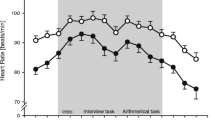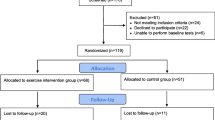Abstract
This study examined the effects of an acute physical stressor on salivary testosterone (Tsal) and cortisol (Csal) and their relationship with the autonomic responsiveness to a mental task in fit young men (n = 30). Salivary testosterone (Tsal) and cortisol (Csal) levels were determined before and after a maximal bicycle exercise. Heart rate (HR) and skin conductance levels (SCL) were continuously recorded before, during, and after a Stroop task. Tsal and Csal levels diminished while HR and SCL increased in response to stressors in all the sample. When subjects were distributed in function of their endocrine response to the physical stressor, high Tsal responders showed higher HR reactivity than low responders, and high Csal responders showed higher SCL reactivity and lower reaction time in the Stroop task. These results show that the influence of an acute physical stressor on hormones is associated with the autonomic responses to a mental task.
Similar content being viewed by others
REFERENCES
Al'Absi, M., Bongard, S., Buchanan, T., Pincomb, G. A., Licinio, J., & Lovallo, W. R. (1997). Cardiovascular and neuroendocrine adjustment to public speaking and mental arithmetic stressors. Psychophysiology, 34, 266–275.
Barrett-Connor, E., & Khaw, K. T. (1988). Endogenous sex hormones and cardiovascular disease in men: A prospective population-based study. Circulation, 78, 539–545.
Buchanan, T. W., Al'Absi, M., & Lovallo, W. R. (1999). Cortisol fluctuates with increases and decreases in negative affect. Psychoneuroendocrinology, 24, 227–241.
Burke, J. H., Goldberger, J. J., Ehlert, F. A., Kruse, J. T., Parker, M. A., & Kadish, A. H. (1996). Gender differences in heart rate before and after autonomic blockade: Evidence against an intrinsic gender effect. American Journal of Medicine, 100, 537–543.
Carrillo, E., Moya-Albiol, L., González-Bono, E., Salvador, A., Ricarte, J., & Gómez-Amor, J. (in press). Gender differences in cardiovascular and electrodermal responses to public speaking task: The role of anxiety and mood states. International Journal of Psychophysiology.
Cauley, J. A., Guttai, J. P., Kuller, L. H., & Dai, W. S. (1987). Usefulness of sex steroid hormone levels in predicting coronary artery disease in men. American Journal of Cardiology, 60, 771–777.
Cohen, J. C., & Hickman, R. (1987). Insulin resistance and diminished glucose tolerance in power lifters ingesting anabolic steroids. Journal of Clinical Endocrinology and Metabolism, 64, 960–963.
Cumming, D. C., Brunsting, L. A., Strich, G., Ries, A. L., & Rebar, R. W. (1986). Reproductive hormone increases in response to acute exercise in men. Medicine and Science of Sports and Exercises, 18, 369–373.
Duda, J. L., Sedlock, D. A., Melby, C. L., & Thaman, C. (1988). The effects of physical activity level and acute exercise on heart rate and subjective response to a psychological stressor. International Journal of Sports Psychology, 19, 119–133.
Fernández-Pastor, J. M., Diego-Acosta, A. M., & Fernández-Pastor, V. J. (1992). Hormonas y ejercicio. In J. González-Gallego (Ed.), Fisiología de la actividad física y el deporte (pp. 95–128). Madrid: Interamericana McGraw Hill.
Girdler, S. S., Jamner, L. D., & Shapiro, D. (1997). Hostility, testosterone and vascular reactivity to stress: Effects of sex. International Journal of Behavioral Medicine, 4, 242–263.
González-Bono, E., Salvador, A., Serrano, M. A., & Ricarte, J. (1999). Testosterone, cortisol and mood in sports team competition. Hormones and Behavior, 35, 55–62.
Gugliemini, C., Paolini, A. R., & Conconi, F. (1984). Variations of serum testosterone concentrations after physical exercise of different durations. International Journal of Sports Medicine, 5, 246–249.
Haffner, S. M., Katz, M. S., Stern, M. P., & Dunn, J. F. (1988). The relationship of sex hormones to hyperinsulinemia and hyperglycemia. Metabolism, 37, 683–688.
Häkkinen, K., & Pakarinen, M. (1993). Acute hormonal responses to two different fatiguing heavyresistance protocols in male athletes. Journal of Applied Physiology, 74, 882–887.
Hugdahl, K. (1995). Psychophysiology: The mind-body perspective. United States: Harvard University Press.
Kirschbaum, C., & Hellhammer, D. H. (1992). Metodological aspects of salivary cortisol measurement. In C. Kirschbaum, G. F. Read, & D. H. Hellhammer (Eds.), Assessment of hormones and drugs in saliva in biobehavioral research (pp. 19–32). Toronto: Hogrefe & Ruber Rb.
Kohlisch, O., & Schaefer, F. (1996). Physiological changes during computer tasks: Responses to mental load or to motor demands? Ergonomics, 39, 213–224.
Linden, W., Earle, T. L., Gerin, W., & Christenfeld, N. (1997). Physiological stress reactivity and recovery: Conceptual siblings separated at birth? Journal of Psychosomatic Research, 42, 117–135.
Litschauer, B., Zauchner, S., Huemer, K. H., & Kafka-Lützow, A. (1998). Cardiovascular, endocrine, and receptor measures as related to sex and the menstrual cycle phase. Psychosomatic Medicine, 60, 219–226.
Lovallo, W. R., & Al'Absi, M. (1998). Hemodynamics during rest and behavioral stress in normotensive men at risk for hypertension. Psychophysiology, 35, 47–53.
MacLeod, C. M. (1991). Half century of research on the Stroop effect: An integrative review. Psychological Bulletin, 109, 163–203.
Mathur, D. N., Toriola, A. L., & Dada, O. A. (1986). Serum cortisol and testosterone levels in conditioned male distance runners and non-athletes after maximal exercise. Journal of Sports Medicine and Physical Fitness, 26, 245–250.
Mayerhofer, A., Bartke, A., & Began, T. (1993). Catecholamines stimulate testicular steroidogenesis in vitro in the Siberian hamster, Phodopus sungorus. Biology of Reproduction, 48, 883–888.
Mayerhofer, A., Steger, R. W., Gow, G., & Bartke, A. (1992). Catecholamines stimulate testicular testosterone release of the immature golden hamster via interaction with alpha-and beta-adrenergic receptors. Acta Endocrinologica, 127, 526–530.
Moya-Albiol, L., Salvador, A., Costa, R., Martínez-Sanchis, S., González-Bono, E., Ricarte, J., & Arnedo, M. (2001). Psychophysiological responses to the Stroop task after a maximal cycle ergometry in elite sportsmen and physically active subjects. International Journal of Psychophysiology, 40, 47–59.
Nieman, D. C., Miller, A. R., Henson, D. A., Warren, B. J., Gusewitch, G., Johnson, R. L., Davis, J. M., Butterworth, D. E., Herring, J. L., & Nehlsen-Cannarella, S. L. (1994). Effects of high versus moderate-intensity exercise on lymphocyte subpopulations and proliferative response. International Journal of Sports Exercise, 26, 128–139.
O'Connor, P. J., Petruzzello, S. J., Kubitz, K. A., & Robinson, T. L. (1995). Anxiety responses to maximal exercise testing. British Journal of Sports Medicine, 29, 97–102.
Perna, F. M., & McDowell, S. L. (1995). Role of psychological stress in cortisol recovery from exhaustive exercise among elite athletes. International Journal of Behavioral Medicine, 2, 13–26.
Phillips, G. B., Yano, K., Stemmermann, G. N. (1988). Serum sex hormones and myocardial infarction in the Honolulu Heart Program: Pitfalls in prospective studies on sex hormones. Journal of Clinical Epidemiology, 41, 1151–1156.
Puigcerver, A., Martínez-Selva, J. M., García-Sánchez, F., & Gómez-Amor, J. (1989). Individual differences in psychophysiological and subjective correlates of speech anxiety. Journal of Psychophysiology, 3, 75–81.
Read, G. F., & Walker, R. F. (1984). Variation of salivary testosterone with age in men. In G. F. Read, D. Riad-Fahmy, R. F. Walker, & K. Griffiths (Eds.), Immunoassays of steroids in saliva (pp. 215–218). Cardiff: Alpha Omega.
Roth, D. L. (1989). Acute emotional and psychophysiological effects of aerobic exercise. Psychophysiology, 27, 694–701.
Roy, M., & Steptoe, A. (1991). The inhibition of cardiovascular responses to mental stress following aerobic exercise. Psychophysiology, 28, 689–700.
Salvador, A. (1995). Respuesta psicoendocrina al estrés competitivo. In E. Cantón (Ed.), Actas del V Congreso de Psicología de la Actividad Física y el Deporte (pp. 92–97). Valencia: Universitat de València.
Sapolsky, R. M. (1982). The endocrine stress-response and social status in the wild baboon. Hormones and Behavior, 16, 279.
Sapolsky, R. M. (1986). Stress-induced elevation of testosterone concentrations in high ranking baboons: Role of catecholamines. Endocrinology, 118, 1630–1635.
Sloan, R. P., Demersman, R. E., Shapiro, P. A., Bagiella, E., Kuhl, J. P., Zion, A. S., Paik, M., & Myers, M. M. (1997). Cardiac autonomic control is inversely related to blood pressure variability responses to psychological challenge. American Journal of Physiology, 272, H2227–H2232.
Steptoe, A., Kearsley, N., & Walters, N. (1993). Cardiovascular activity during mental stress following vigorous exercise in sportsmen and inactive men. Psychophysiology, 30, 245–252.
Suay, F., Sanchís, C., & Salvador, A. (1997). Marcadores hormonales del síndrome de sobreentrenamiento. Revista de Psicología del Deporte, 11, 21–39.
Szabó, A., Brown, T. G., Gauvin, L., & Seraganian, P. (1993). Aerobic fitness does not influence directly heart rate reactivity to mental stress. Acta Physiologica Hungarica, 81, 237–245.
Szabó, A., & Gauvin, L. (1992). Reactivity to written mental arithmetic: Effects of exercise lay-off and habituation. Physiology and Behavior, 51, 501–506.
Szabó, A., Péronet, F., Frenkl, R., Farkas, A., Petrekanits, M., Meszaros, J., Hetenyi, A., & Szabó, T. (1994). Blood pressure and heart rate reactivity to mental strain in adolescent judo athletes. Physiology and Behavior, 56, 219–224.
Tulen, J. H. M., Moleman, P., Van Steenis, H. G., & Boomsma, F. (1989). Characterization of stress reactions to the Stroop Color Word Test. Pharmacology, Biochemistry and Behavior, 32, 9–15.
Viru, A. (1992). Plasma hormones and physical exercise. International Journal of Sports Medicine, 13, 201–209.
Vitaliano, P. P., Russo, J., Paulsen, V. M., & Bailey, S. L. (1995). Cardiovascular recovery from laboratory stress: Biopsychosocial concomitants in older adults. Journal of Psychosomatic Research, 39, 361–377.
Wheeler, G., Cumming, D., Burnham, R., MacLean, I., Sloley, B. D., Bhambhani, Y., & Steadward, R. D. (1994). Testosterone, cortisol and catecholamine responses to exercise stress and autonomic dysreflexia in elite quadriplegic athletes. Paraplegia, 32, 292–299.
Author information
Authors and Affiliations
Corresponding author
Rights and permissions
About this article
Cite this article
Moya-Albiol, L., Salvador, A., González-Bono, E. et al. The Impact of Exercise on Hormones Is Related to Autonomic Reactivity to a Mental Task. International Journal of Stress Management 8, 215–229 (2001). https://doi.org/10.1023/A:1011391109602
Issue Date:
DOI: https://doi.org/10.1023/A:1011391109602




